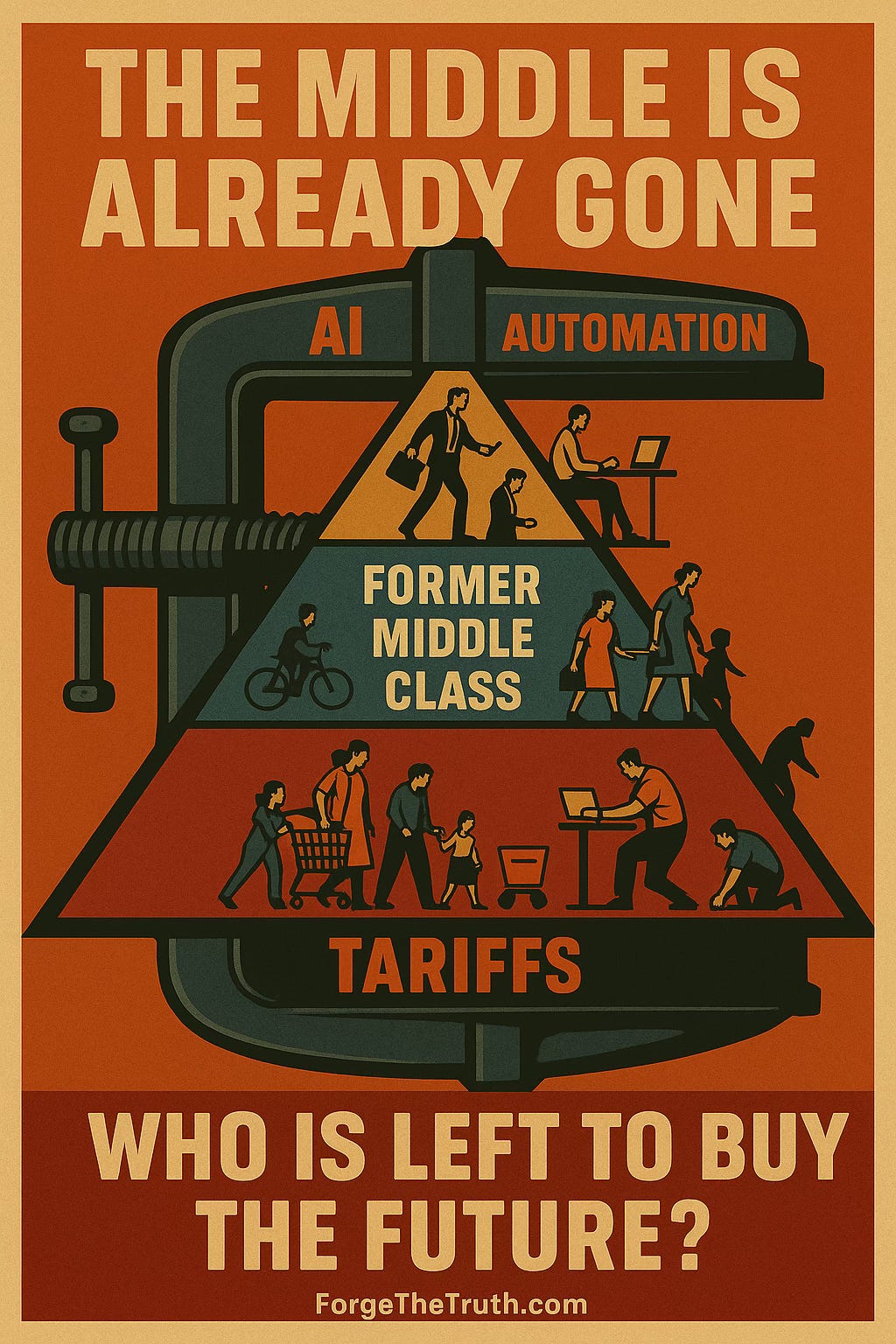The Middle Is Already Gone
Tariffs squeeze the growing poor, AI undercuts the last high earners. Who is left to buy the future?
August 10, 2025, Seattle, WA
The American middle class was once the engine of the economy. It bought the cars, the homes, the appliances, and the next big thing in tech. That class has been fading for decades. Now two forces are acting like a vice on what is left of broad-based prosperity. Tariffs are pressing down on the growing poor, while AI is cutting into the last safe harbor for high earners. The gap between the two sides is where the economy breaks.
Jaw One of the Vice: Tariffs as a Regressive Tax
The 2025 tariff package has driven U.S. import taxes to their highest level since 1933. Yale’s Budget Lab estimates the average household will lose about $3,800 a year from higher prices. Lower-income households lose a larger share of their income, making tariffs a textbook regressive tax. (Budget Lab – Yale)
The averages hide sharper pain. Essential categories like apparel have jumped 17 percent, motor vehicles 12 to 20 percent, and fresh produce around 7 percent. Middle-income households, what is left of them, are taking hits similar to the poor. Meanwhile, the top decile absorbs the increases with barely a dent in their spending power. (MarketWatch)
Without a middle class to buffer the blow, tariffs now fall hardest on those already stretched thin. It is a squeeze from the bottom.
Jaw Two of the Vice: AI Eats the Top of the Pyramid
For decades, high-paid tech and professional workers were insulated from the economic erosion hitting the rest of the workforce. That protection is vanishing. AI is automating the work of consultants, coders, analysts, and junior legal staff. Anthropic’s CEO warns that up to 50 percent of entry-level white-collar jobs could disappear within five years, potentially driving unemployment to 10 to 20 percent. (Axios)
The cuts have started. More than 10,000 U.S. jobs this year have been directly attributed to AI. Tech outsourcing giant TCS in India just announced 12,000 layoffs as part of an AI restructuring. (Reuters) Mo Gawdat, former Google executive, predicts a 15-year period of professional displacement starting around 2027, reaching well into high-skill, high-wage roles. (NY Post)
AI is squeezing from the top, stripping away the income base that once drove demand for high-end goods and services.
The Space Between the Jaws
With tariffs pulling down the bottom and AI cutting off the top, there is less consumer capacity across the board. In 1971, 61 percent of Americans lived in middle-income households. By 2023, it was 51 percent and falling. (Pew Research)
Today, the top 20 percent of earners account for nearly 40 percent of all consumer spending. The rest are falling behind. Household debt is at $18.39 trillion, with delinquencies rising. Credit is bridging purchases for now, but the bridge is shaky.
The result is an economy where a shrinking group can afford new products at launch price, while the rest wait for discounts or opt out entirely. That dynamic weakens the demand curve that has powered growth for generations.
Who Is Left to Buy the Future?
Top decile and asset holders: Still able to pay cash or secure favorable financing for premium products.
Enterprises and government: Budgets for AI, automation, and infrastructure remain, but they are not household buyers.
Global elites: International demand for luxury can prop up some sectors.
Price-sensitive consumers: They will re-enter only when prices drop or products become essential.
Is this the future we want?
What You Can Do Now
If the vice is tightening from both ends, the way out is through collective and community power:
Join or strengthen a union: Collective bargaining remains a proven way to protect wages and working conditions.
Vote with your wallet: Reward companies that invest in workers and communities.
Buy local, hire local: Keep spending power in your community.
The middle class may be gone, but a balanced economy is still possible if we focus on adapting to AI while reducing the harm from tariffs and other regressive forces.

